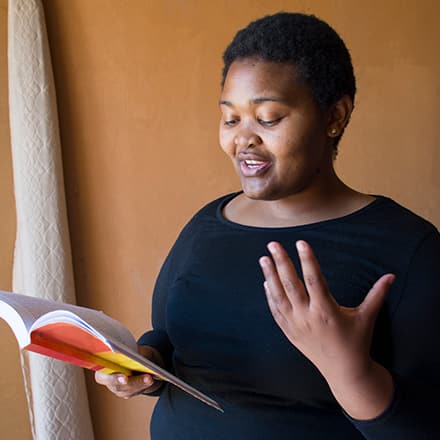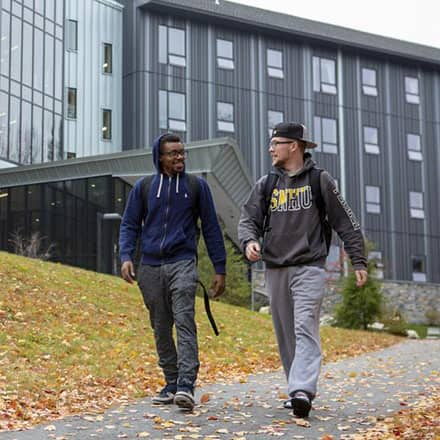What is Media Literacy?

Media literacy is the practice of taking in media messages and understanding their influence on your thoughts, feelings and behaviors. In an increasingly technology-focused world, it's a skill people of all ages can benefit from.
Dr. Russell Ortega Milligan, a graduate communication instructor and academic partner at Southern New Hampshire University (SNHU), emphasized the importance of media literacy. With over 20 years of experience in the communication field — many of which have been spent coaching students and leaders — Milligan promotes the value of critical thinking when consuming information.
“When we’re media literate, we can make informed decisions about products and services,” he said. “Questioning information puts us in a better position to seek different perspectives, evaluate information and understand our own thinking. Ultimately, we empower ourselves to become better problem-solvers instead of accepting information at face value.”
What is the Best Definition of Media Information Literacy?

Over the last several decades — particularly with the introduction of the internet and social platforms — the definition of what constitutes “media” has grown significantly. As a result, Milligan noted, it’s important that people learn how to adapt to a changing landscape.
“At its core, I think of media literacy as our ability to interpret and engage with various media types: visual images, audio messages and digital content, including social media platforms,” said Milligan. “This broader perspective allows us to develop and use our critical skills for analyzing messages and understanding the impact of media on our daily lives.”
What Are Examples of Media Literacy in Action?
When you interact with a media message, Milligan said, it can be helpful to ask yourself some key questions:
- Who owns or controls this message?
- Can I identify any bias in this message?
- Are there recognizable stereotypes in this message?
When you ask these questions, you're developing your media literacy. According to Milligan, the goal — and impact — of media literacy is thoughtful engagement and informed decision-making about the information you consume.
Understanding Media Ownership
When you encounter a media message — an Instagram post about a news story, for example — it’s important to know who the message is coming from. Media ownership shapes the stories you hear, Milligan noted. As a result, these stories can be influenced by personal or corporate interests, and might include inaccurate information. Or, they could leave out key details that change the message significantly.
“By understanding the possible agendas behind a message, we also become better equipped to evaluate its credibility — and the intentions of its creators," Milligan said.
You can start, he said, by not only asking who wrote the article or shared the social media post but also by exploring that person’s background and personally held beliefs. These personal details can impact the way a message is delivered.
“When I encounter this issue, I collect data from various sources and cross-check information,” Milligan said. “Doing so ensures I’ve covered my bases for reporting a balanced, fair report.”
With some critical thinking, you can determine if the message you’re receiving is accurate — or if it may be influenced in some way.
Identifying Bias
Another example of media literacy in action is working to uncover any kind of bias that might be present within a message. According to Milligan, this is something that happens frequently across all media channels.
When you suspect you may be engaging with biased media, he said a good best practice is examining the language and tone of the message, and other elements that make the content unique to the author. Sometimes, though not always, these context clues can lead you to uncovering bias.
Other times, bias can be identified due to a lack of cited sources. Or, the sources the author chooses to cite may be questionable or unverified. Media-literate individuals are quick to look for purposeful omissions or one-sided narratives, too. Ultimately, Milligan noted, identifying bias is about peeling back the layers of a message.
“When people dig underneath the surface, much like an archeologist would do to find hidden treasure, they can better understand the topic and decide whether the information is factual and trustworthy," he said.
Recognizing Stereotypes
Media literacy also involves being mindful of harmful stereotyping — in movies, on news channels and across social media platforms. According to the National Commission for the Promotion of Equality (NCPE), there are a number of common stereotypes portrayed in the media (NCPE PDF Source). These stereotypes might be centered around various identities, including:
- Culture
- Gender
- Race
- Sexual orientation
Milligan emphasized that when you’re trying to determine if a stereotype is present, you can turn, again, to the most important skills of media literacy: employing critical thinking and asking thoughtful questions.
“For example, I encourage others to consider whether a movie negatively represents people with a particular hair color or texture,” he said. “Or, does a news story portray specific communities in a negative light that reinforces stereotypes instead of offering a balanced point of view?”
In addition to being conscious of the media you’re consuming, recognizing stereotypes allows you to go a step further. When you’re media literate, you have the power to change the damaging narratives you're seeing — and promote accurate narratives instead.
“When we uncover stereotypes, we can challenge the status quo by promoting inclusivity and diversity in our work,” Milligan said. “Whether we’re writing an internal communication for the CEO or a blog article for a client, we can shift the narrative toward presenting a point of view that respects humanity.”
What is the Impact of Media Literacy?
When you learn and practice media literacy skills, you understand messaging not only for what it appears to be, but for what it actually is.
“We come away with clarity, accuracy, relevance and significance,” said Milligan.
The impact of media literacy is that you as an individual — and society at large — avoid gravitating toward generalizations and prejudice, and instead move toward open-mindedness and truth, he said. And while there are challenges along the way — like discerning between real and fake information — media literacy skills like understanding media ownership, identifying bias and recognizing stereotypes can help you feel more confident in your ability to make that discernment.
If you’re interested in studying the impact of media and media literacy, a degree in communication might be the right fit. In SNHU’s communication degree program, students learn how to strategize and deliver effective messages. You could also choose to add a concentration in new media, which would allow you to study new media technology, social media research and marketing, content production and more.
“Education and applying our learning are essential for improving our media literacy skills,” Milligan said. "These skills put us in a better position to seek different perspectives, evaluate information and expand our thinking."
Discover more about SNHU's communication degree: Find out what courses you'll take, skills you'll learn and how to request information about the program.
Abigail (Abby) Mark ’23G is a copywriter and contributing content writer at Southern New Hampshire University (SNHU). Prior to her role in marketing, Abby spent four years on SNHU’s student experience team as an academic advisor and team lead of academic advising. In 2018, she graduated from Saint Anselm College with a Bachelor of Arts in Psychology and went on to earn her Master of Arts in English & Creative Writing at SNHU in the spring of 2023.
She is also an adjunct faculty member at SNHU and is passionate about sharing her love for creative writing with online undergraduate students. Abby hopes her writing will help prospective students and employees alike see just how transformative SNHU could be for them (as it’s been pretty transformative for her). You can connect with her on LinkedIn.
Explore more content like this article

Why is Poetry Important? Celebrating National Poetry Month

Meet Betty White Stamp Artist Dale Stephanos, SNHU Graphic Design Grad

SNHU Spotlight: Dennis Peacock, BA in Graphic Design Grad
About Southern New Hampshire University

SNHU is a nonprofit, accredited university with a mission to make high-quality education more accessible and affordable for everyone.
Founded in 1932, and online since 1995, we’ve helped countless students reach their goals with flexible, career-focused programs. Our 300-acre campus in Manchester, NH is home to over 3,000 students, and we serve over 135,000 students online. Visit our about SNHU page to learn more about our mission, accreditations, leadership team, national recognitions and awards.

